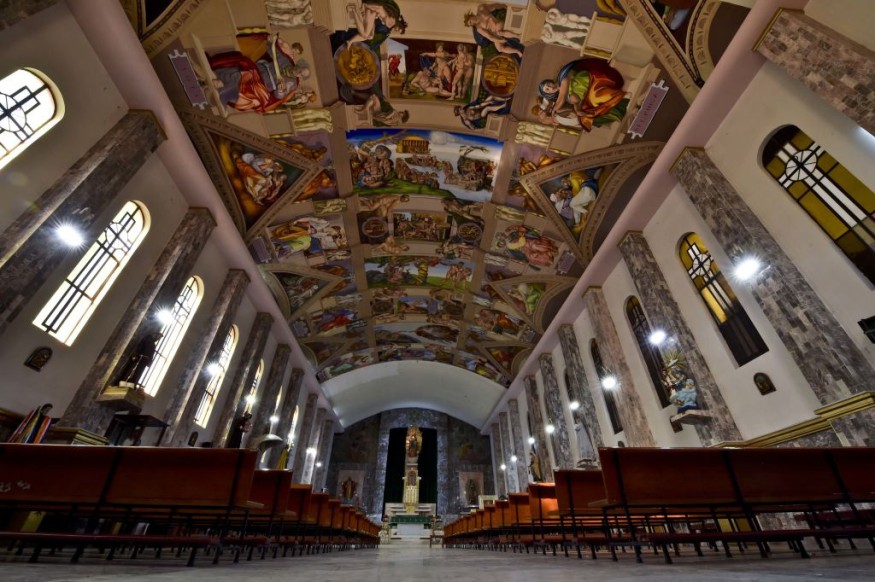Mexico Culture: Indigenous Resilience Found in Ornately Painted Churches

The resilience of Mexicans can be seen on the art painted on their place of worships where angels held harps, guitars, and violins in their hands, their Baroque lips smiling, like an image of heaven replete with music and joy, set in iridescent medallions against a blue-green field twisted with gold and crimson filigree.
The first thing that residents of the Mexican village of Nurio saw when they walked through the hefty wooden doors of their mud-plastered church for centuries was an orchestra of angels.
Believed to be completed in the mid-1600s, the images were painted on pine panels mounted in an arch beneath the choir. It is less than 150 years since the first Franciscan missionaries arrived in the Meseta Purépecha, or Tarascan Plateau, a highland region in the Michoacán state named for the Indigenous community that resides there.
Nurio's Church Indigenous Resilience After Fire, Interventions
On March 7, 2021, a fire broke out among the church's thin ceiling shingles, allegedly caused by a short circuit under the roof or a firecracker that blew off course.
However, the winds that day were particularly fierce, and every time they managed to put out the flames, a new gust would reawaken them. People in the community removed what they only could from the smoke-filled hall, including a crucifix in a glass and an image of Nurio's patron.
The fire wreaked havoc on Nurio's 5,000 residents, but before the incident, Nurio's church had seen several interventions since the '70s.
In the 2010s, community members asked the National Institute of Anthropology and History (I.N.A.H.), who safeguards Mexico's constructed legacy, to replace the historic shingles with low-maintenance galvanized steel. The ministry of culture, which supervises I.N.A.H., resisted and offered its own repair project two years later; state and federal institutions were still discussing funding when the church caught fire.
Authorities pledged to rebuild the church exactly as it had been, and its reconstruction began within the month.
Such approaches to conservation first emerged in the mid-19th century, primarily through the work of French architect Eugène-Emmanuel Viollet-le-Duc, reaching apotheosis in the neo-Gothic spire.
A contemporaneous and ideological adversary, the English writer John Ruskin, argued alternatively for the valorization of decay. In his 1849 treatise "The Seven Lamps of Architecture," structures from the past "are not ours."
Over the next 50 years, theorists came to see architectural monuments as "an indispensable link in the developmental chain of art history," the Austrian academic Alois Riegl wrote.
As the 20th century progressed, nationalist movements in countries like Italy, Germany, Poland, and Mexico turned to their built heritage to fortify a fragile sense of shared cultural identity.
After the damage wrought by World War II, the rhetoric of conservation turned toward universalism, as enshrined in 1964's Venice Charter. Signatories from 19 countries, including Mexico, affirmed the agreement, which said that historic monuments reflected "the unity of human values" and a shared inheritance, to "safeguard for future generations."
The Venice Charter made a nod to the importance of modern use, but strict conservationism prioritizes the past almost by definition, leaving little room for what they called "the restless and discontented present."
Churches Found in Central Michoacán Defined by Its History
Nurio's church, like the few others scattered across central Michoacán, is neither monument nor memorial, but the history that produced it, is defined as much by violence and subjugation as it is by resistance and resilience.
Though painted churches may be found all over Mexico, few compare to Meseta's chapels in terms of the stunning contrast of simplicity and decoration, as well as the precise use of color.
The figurative depictions of angels, virgins, saints, and martyrs that adorn the wooden ceilings of these modest structures bear little resemblance to the puzzle-like geometry of many pre-Hispanic paintings.
Yet the Indigenous dyes and pigments they likely used connect them to a previous world, turning every panel into a document of culture in the midst of devastating change.
In the seminal 1948 book titled "Mexican Architecture in the Sixteenth Century" of American art historian George Kubler: "Each building, and each colonial artifact, was nourished by the destruction of a culture, and the decline of a race."
Images, on the other hand, are infinitely mutable, their meanings shifting as cultures develop. The churches of the Meseta, and the paintings they contain, were built to eliminate a civilization, but they now stand as precious artworks and historical records, as well as sacred sanctuaries through which a long-suppressed culture can rewrite its story on its own terms.
This article is owned by Latin Post.
Written by: Jess Smith
WATCH: Why Is There A Pink Gothic Church In This Mexican City? | Curious Traveller | Absolute History - from Absolute History
Subscribe to Latin Post!
Sign up for our free newsletter for the Latest coverage!












